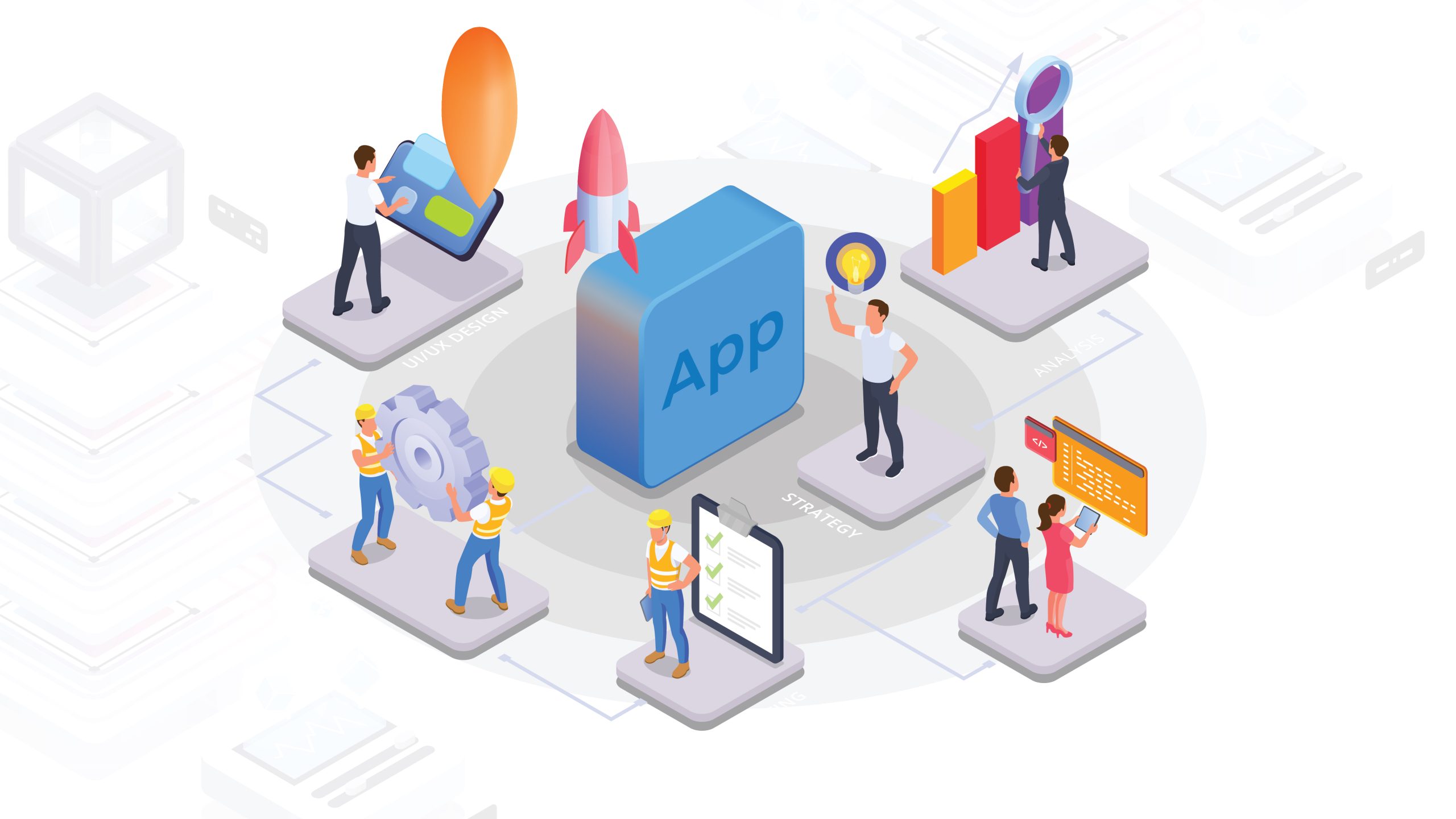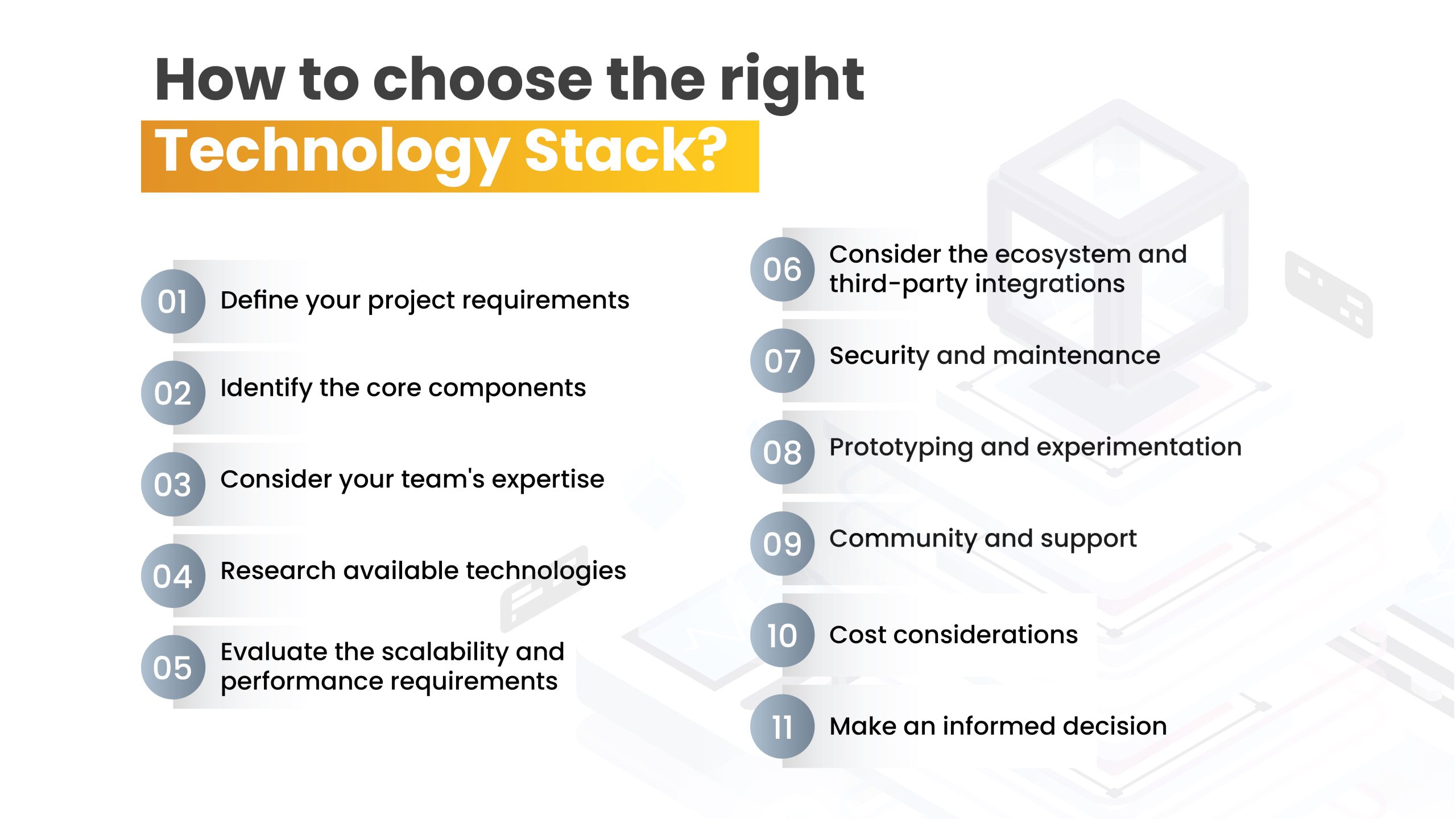A Strategic Approach For Selecting the Right Technology Stack for Your App
Just as you can’t create a great dish with low-quality ingredients, the same principle applies to software development. Therefore, selecting the optimal stack for web development is a crucial initial step in the project lifecycle. It serves as the foundation for customizing the product according to your objectives, enhancing its performance, and improving the productivity of the assigned developer.

The appropriate tech stack for a website ensures that your product is of high quality and fulfills customer expectations. By selecting the right technology stack for web development that aligns with your product requirements before starting the project, you can prevent numerous issues. Making an intelligent decision from the outset saves you the trouble of having to fix or update the product later on. Notably, it can result in significant savings in terms of budget and time.
As a leading mobile app development company, we have extensive expertise in choosing the right technology stack for your app. We understand the importance of selecting the most suitable tools and frameworks to ensure the success and efficiency of your project. With our knowledge and experience, we can guide you in making informed decisions that align with your app’s requirements and goals.
What is a technology stack?
As a mobile app developer, the technology stack for developing a mobile app typically depends on the specific requirements of the project, target platforms (iOS, Android, or both), and personal preferences. However, here’s a general overview of a typical technology stack for mobile app development:
Programming Languages:
- Swift: Used for developing iOS apps.
- Kotlin: Used for developing Android apps.
- React Native: A JavaScript framework used for cross-platform app development.
Development Frameworks and Libraries:
- iOS: Xcode, CocoaTouch, SwiftUI, UIKit.
- Android: Android Studio, Android SDK, Jetpack (AndroidX), Retrofit.
Backend Development:
- Server-Side Programming Languages: Node.js, Python, Ruby, Java, PHP, etc.
- Frameworks: Express.js, Django, Ruby on Rails, Spring Boot, Laravel, etc.
- Database: MySQL, PostgreSQL, MongoDB, Firebase, SQLite, etc.
- RESTful APIs: Used for communication between the mobile app and the backend.
User Interface (UI) and User Experience (UX):
- iOS: Interface Builder, Auto Layout, SwiftUI.
- Android: XML Layouts, ConstraintLayout.
- Cross-platform: React Native, Flutter.
Version Control:
- Git: Most commonly used version control system for tracking changes in the codebase.
Deployment and Testing:
- App Distribution Platforms: App Store (iOS), Google Play Store (Android).
- Testing Frameworks: XCTest, Espresso, Jest, Detox, Appium.
- Continuous Integration/Continuous Deployment (CI/CD) Tools: Jenkins, CircleCI, Travis CI.
It’s important to note that the technology stack may vary depending on the specific requirements of your app and the skill set of your development team. Additionally, new technologies and tools are constantly emerging in the mobile app development landscape, so staying up-to-date with the latest trends is crucial.
How to choose the right technology stack?
Choosing the right technology stack for your app is an important decision that can impact its performance, scalability, development time, and maintenance. Remember that choosing a technology stack is not a one-time decision. It’s important to regularly evaluate the performance and scalability of your app and be open to adopting new technologies if they better suit your evolving needs. Flexibility and adaptability are key in the rapidly evolving technology landscape.

- Define your project requirements: When defining your project requirements, consider the purpose of your app, the target audience, and the specific features you want to include. For example, if you’re building an e-commerce app, you may need features like user authentication, product listings, shopping cart functionality, and payment integration. By having a clear understanding of your requirements, you can better identify the technologies that will support those needs.
- Identify the core components: Breaking down your app into core components helps you understand the specific technology requirements for each part. Here are some common components:
- Front-end (client-side): This involves the user interface and user experience of your app. Consider the technologies for building the user interface, such as HTML, CSS, and JavaScript, as well as front-end frameworks like React, Angular, or Vue.js.
- Back-end (server-side): The back-end handles the logic and processing of your app. It includes the server, application, and database. Choose a server-side technology like Node.js, Ruby on Rails, Django, or ASP.NET, depending on your preferences and requirements.
- Database: Determine the type of database you’ll need, such as relational (e.g., MySQL, PostgreSQL) or NoSQL (e.g., MongoDB, Cassandra) based on the data model and scalability requirements of your app.
- External services or APIs: If your app needs to integrate with third-party services or APIs (e.g., payment gateways, social media platforms), consider the technologies that support those integrations.
- Consider your team’s expertise: Assess the skills and expertise of your development team. If your team has experience with specific technologies, frameworks, or programming languages, it may be beneficial to leverage their expertise. Utilizing familiar technologies can lead to faster development and better code quality. However, be open to exploring new technologies if they align better with your project requirements and can be learned effectively by your team.
- Research available technologies: Conduct thorough research on the available technologies and frameworks for each component of your app. Consider factors such as programming languages, frameworks, libraries, and their compatibility with your project requirements. Look for technologies with good documentation, active communities, and a track record of successful projects. Explore case studies and examples of apps built using those technologies to assess their suitability.
- Evaluate the scalability and performance requirements: Consider the expected scale and performance needs of the app. Will it handle a small user base or millions of concurrent users? Determine whether you need technologies that can scale horizontally (e.g., through load balancing) or vertically (e.g., by optimizing hardware resources). Look for technologies that can handle your anticipated traffic and provide good performance.
- Consider the ecosystem and third-party integrations: Assess the ecosystem around the technologies you’re considering. Look for a robust ecosystem with a wide range of third-party libraries, tools, and services that can enhance your development process. Consider factors such as the availability of APIs, community support, and compatibility with popular services you may need to integrate with, such as cloud platforms or analytics tools.
- Security and maintenance: Security is a critical aspect of any app. Look for technologies with a strong security track record and a community that actively addresses security vulnerabilities. Consider factors like built-in security features, encryption options, and the availability of security patches and updates. Additionally, assess the long-term maintenance requirements of the technologies you choose. Ensure they have active development and community support to address any issues that may arise.
- Prototyping and experimentation: Creating prototypes or proof-of-concept projects using different technologies can provide valuable insights. By building small-scale versions of your app using different technology stacks, you can assess their suitability for your project. Consider factors like development speed, ease of use, code maintainability, and the ability to achieve your desired functionality. This hands-on approach helps you make more informed decisions based on practical experience.
- Community and support: Evaluate the size and activity of the communities surrounding the technologies you’re considering. A large and active community can offer various benefits, such as readily available resources, tutorials, documentation, and community-driven support. They can help troubleshoot issues, provide guidance, and offer best practices. Active communities also indicate that the technologies are being actively maintained and updated.
- Cost considerations: Evaluate the cost implications of your technology stack. Consider factors like licensing fees for commercial software, hosting costs, infrastructure requirements, and ongoing maintenance expenses. Open-source technologies can often reduce costs, but be mindful of additional expenses for premium support or enterprise features if needed. Assess the long-term cost-effectiveness of your chosen technologies to ensure they align with your budget and financial resources.
- Make an informed decision: Based on the information gathered from the previous steps, weigh all the factors and decide on the technology stack that best suits your project. Consider the trade-offs and prioritize the factors that are most critical for your app’s success. It’s important to strike a balance between the requirements, team expertise, scalability needs, security considerations, available resources, and long-term sustainability.
In the ever-evolving world of app development, choosing the right technology stack is crucial for success. It determines the performance, scalability, and maintenance of your app. By following the steps outlined in this blog, you can make an informed decision that aligns with your project requirements, team expertise, and long-term goals.
At Black Widow Tech, we understand the importance of selecting the right technology stack for your app. As a leading mobile app development company in Texas and a top mobile app development company in the USA, we specialize in creating custom mobile apps for various industries. Our team of experienced professionals has expertise in a wide range of technologies and frameworks.
We go beyond just development and assist our clients in choosing the ideal technology stack for their apps. With a thorough understanding of your project requirements and industry landscape, we help you navigate through the vast array of options available. Our expertise allows us to recommend the most suitable technologies that ensure optimal performance, scalability, and security for your app.
As a top mobile app developer in the USA, we take into account factors such as your app’s complexity, scalability needs, and integration requirements. We leverage our knowledge of the latest frameworks, libraries, and tools to guide you toward the best technology choices. We aim to provide you with a technology stack that not only meets your current needs but also sets a strong foundation for future growth and enhancements.
Partnering with Black Widow Tech means gaining access to a team that excels in app development and acts as your trusted advisor in technology selection. We believe that a well-chosen technology stack is the backbone of a successful app, and we are committed to helping you achieve your goals.
So, whether you’re a startup, a small business, or an enterprise, rely on Black Widow Tech as your trusted top mobile app development company in the USA. We are here to support you throughout the app development journey, from technology stack selection to the delivery of a high-quality, feature-rich app that exceeds your expectations.
Get in touch with Black Widow Tech today and let us help you choose the right technology stack for your app, ensuring a successful and impactful digital presence.
